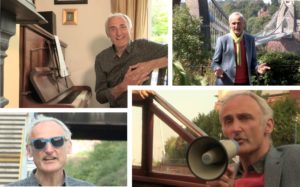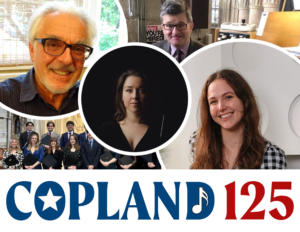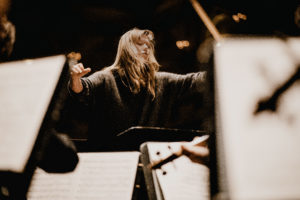
There are some Copland pieces that are harder to hear than others. Many are published but underplayed gems. Then there are numerous unpublished pieces of juvenilia (pre 1920) and incidental music from plays produced in the 1930s and 1940s. And then there is The World of Nick Adams, a TV soundtrack that is permanently available in one place – The Paley Center for Media in New York City.
The Paley Center is an amazing repository of old TV programmes with 160,000 items in its library. When I first went there in 1998, I found it amusing that me and my sister were watching Charlie Brown cartoons whilst some young Americans of our age were watching Wallace and Gromit! If there is a programme that you remember from your youth that isn’t on YouTube then chances are it will be at the Paley Center.
Such is the case with The Seven Lively Arts: The World of Nick Adams, a one-off teleplay from 1957. Now this was shown many years before I was born so I had never seen it. The reason I was interested was that this was one of only a couple of forays by Copland into the world of TV soundtracks. (The other being the short brassy theme tune for CBS Playhouse in 1966).
This is Copland’s only soundtrack that hasn’t been released in any form so you can imagine my excitement when I found out that it was available to watch during my New York trip in May.
 The Nick Adams Stories by Ernest Hemingway are a series of 24 short stories written over a period of 9 years from 1924 to 1933. They are supposedly semi-autobiographical and are a bit of a hodge podge of vignettes from a young man’s life as he grows to maturity, the encounters he has, the people he meets, his reminiscences and regrets. The book includes stories set in the woods of Illinois (Nick recounting his Dad’s encounters with native Americans), his teenage years as a bad apple), on the road with hobos and and as a soldier in Italy and post war times as a single man and then as a husband and father.
The Nick Adams Stories by Ernest Hemingway are a series of 24 short stories written over a period of 9 years from 1924 to 1933. They are supposedly semi-autobiographical and are a bit of a hodge podge of vignettes from a young man’s life as he grows to maturity, the encounters he has, the people he meets, his reminiscences and regrets. The book includes stories set in the woods of Illinois (Nick recounting his Dad’s encounters with native Americans), his teenage years as a bad apple), on the road with hobos and and as a soldier in Italy and post war times as a single man and then as a husband and father.
I’ve read them a couple of times. I must confess that the jury is still out. They are certainly of their time and I was particularly disturbed by the liberal use of the N word in The Killers. I also find Hemingway’s use of dialogue to be awkward on occasions. It might have sounded right in his head or be in context when done on the stage/screen but there are times when I have read and re-read a section again and again to try and make sense of it, only to give up and move on. Reservations aside though, I must admit that his straightforward writing style is well suited to co-exist with Copland’s lean orchestration. Also, some of the stories are such well-drawn, slices of life that you can easily imagine yourself being a fly on the wall.
The 5 stories used in the TV play are:
- Now I Lay Me – Nick as a soldier in Italy, shell shocked, injured and a chronic insomniac, looking back on snap shots from his life.
- The End of Something – Nick ends a relationship with his girlfriend Marjorie whilst out on a fishing trip.
- The Three Day Blow – Nick and his friend Bill get drunk as a storm rolls in.
- The Light of the World – Nick and Bill’s encounters with sex workers and a homosexual in a train waiting room.
- The Battler – Having been beaten up and thrown off a train, Nick chances upon an odd couple who offer him food and shelter (for a while at least).
The TV programme was the brainchild of AE Hotchner. He is by no means a household name (in the UK at least) but he had one of the great lives. Hotch, as he was affectionately known, worked in plays, TV and films, wrote the biography of Hemingway and on a whim set up the Newman’s Own salad dressing company with Paul Newman! They put all the profits into a charity called the Hole in the Wall Gang which provides summer camps for kids with cancer. He died in 2020 at the age of 103 and, as a centenarian, was still sharp as a tack. He wrote his final book, a memoir of sorts called The Amazing Adventures of Aaron Broom aged 99! He’s the sort of person you would have had as a guest at your dream dinner party!
You can hear Hotch speaking about his great life in these reminiscences on the Washington University in St Louis Libraries website. A couple of the Hotch at 100 series feature him talking about The World of Nick Adams, how he managed to persuade Copland to write the soundtrack and then how it took on a new life years later as a fund raising play starring Hollywood A-listers.
I went to the Paley Center twice. The first time I simply watched the hour-long play to try and get the mood. The second time I did my best to take copious notes. Each $20 session at the Paley Center is limited to 90 minutes so apologies for any inaccuracies.
Soundtrack Cues
Copland’s score for The World of Nick Adams was for chamber orchestra but interestingly, without oboes. It has the following cues:
- 00:00 to 00:15 Opening fanfare. Classic fanfare heavy on the brass and very short. This cue could actually be later recycled as the finale of Something Wild (Reunion). It is definitely about the same length and very similar to my ear.
- 02:25- 03:15 Nick in Italy “When you go to war as a boy…/ I was dead then”. Starts melancholy and then just as the bomb is about to land it becomes discordant and agitated. This cue points forward to the psychological music used in Something Wild.
- 03:50 – 04:45 Title sequence “Dear Jesus don’t let me die”. Very serious with big brass and percussion. Not unlike Preamble for a Solemn Occasion. It’s quite strident – very much in Copland’s “laying down the law style”.
- 04:45-06:40 “It’s my leg, watch my leg. Long time between a wound and a healing” / Wind / Silkworms. Starts sombre and uneasy as Nick paces around. There’s a hint of Mary Ann Resigned from Something Wild as he sits down and listens to the silkworms. As “he let’s himself go” thinking about the attic in his grandfather’s house in Michigan where he was born, there is a noble theme played by the flute.
- 10:30-12:15 “I had almost married once / All the girls I ever knew”/ Repeated and persistent three note motif with some variation at once suggesting sadness and indecision or perhaps an off kilter heartbeat. This was the only piece that had an ear worm quality. (That said, the ear worm was lost shortly after!)
- 13:50 – 15:40 “Everything has gone to hell inside of me / there comes the moon / It isn’t fun anymore/Isn’t love fun?” Repeat of cue 5 but this time it uses sombre strings and bass clarinet which further suggests the weight of the impending decision on Nick’s shoulders. When Marjorie says “Isn’t love any fun?” the motif is played by a more hopeful flute but this hint of light is quickly snuffed out as the sombre strings resume.
- 16:12 – 17:00 “And so I had lost her / But it helped to have a good friend like Bill” Slightly different cue only in as much that the wind in the trees is imitated by the instrumentation.
- 26:40-27:20 Three day blow / “I could put out my arms and just let it take me/That night my mind was full” There is a brief hint of grotesquery (reminiscent of Burlesque from Music for the Theatre) to suggest the sort of slumbering hallucinatory madness brought from lack of sleep.
- 39:25-41:15 “Which way are you two boys going? – the other way from you” / “The night can be a dreadful time for lonely people once the loneliness has started”. From saying goodbye to Bill to thinking about “other lonely and fearful times”. More sombre strings accompany the introspection reminiscent of Quiet City and Something Wild – ends with a very long, drawn out, low woodwind note.
- 55:25- 58:10 “It’s funny, when you run away as a boy… / It’s gonna be a hot day / Nothing could happen to me that hasn’t happened to all men before”. Starts off similarly sombre but as he resolves “wondering how you got here” and “you finally stop running and it’s morning and you feel better” at 56:00 there is a noble theme in a muted trumpet. When Nick’s compatriot says “it’s gonna be a hot day, with that lousy sun” the introduction of flutes at 56:45 are suggestive of rays of sunshine. When he adds “men can’t get along who don’t sleep” there is a return of the noble theme but more emphatic and emboldened then quietly resolved. When Nick states “I had to do what all men had always done” there is a similarity to the ending of Appalachian Spring in its resolution. This is possibly the most tuneful bit of the whole score.
I would love to say I had found a lost gem. In truth, this was very much incidental music. If it was recorded, I am certain I would be thrilled but I am not sure it would have that effect on many. I believe that Copland said himself that
Some incidental music is more incidental than others”.
whilst my friend Michael Boriskin, the CEO of Copland House is quoted as saying that The World of Nick Adams score is ”not extensive or thoroughgoing enough to have an independent life.”
Of course, improved sound quality would definitely help as some of the nuance of the soundtrack was almost certainly lost due to 1950’s technology, it being a live broadcast, and the competition with dialogue or the war sound effects in the early action scenes.
There were just 10 cues and a total of just 12.35 minutes of music. This modest amount of music is as a result of the amount of dialogue in the film. Copland’s music typically bridges the different scenes or is there to provide the unspoken thoughts of Nick and Marjorie. There is virtually no music in the central part of the programme. I felt that there was not enough variation and no real modulation after the opening fanfare and title sequence. Apart from that three-note motif in cue 5, there was nothing close to a memorable tune. If released, I think it would have to come out as individual cues as it would make a pretty uninspiring suite. (Please bear in mind, that I only got two listens and some Copland takes a while to gestate before the tunes emerge).
What was interesting to me though was that I had been expecting a much more melodic treatment. Howard Pollack’s biography (Aaron Copland: The Life and Work of an Uncommon Man) suggests that the music was similar to Copland’s “outmoded” incidental music from the late 30s and early 40s (Quiet City and Our Town). But for me this is closer to the complex, psychological, somewhat disturbing music in Something Wild. As such, it felt like a stepping stone forward rather than one going back.
So, perhaps not one of Copland’s finest then, but I’m really happy that my trip to the Paley Center helped me tick off another lesser spotted / lesser heard work.









Leave a Comment